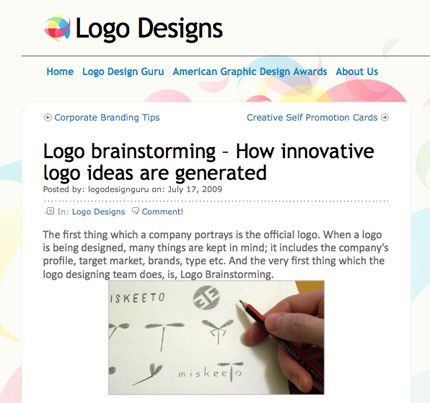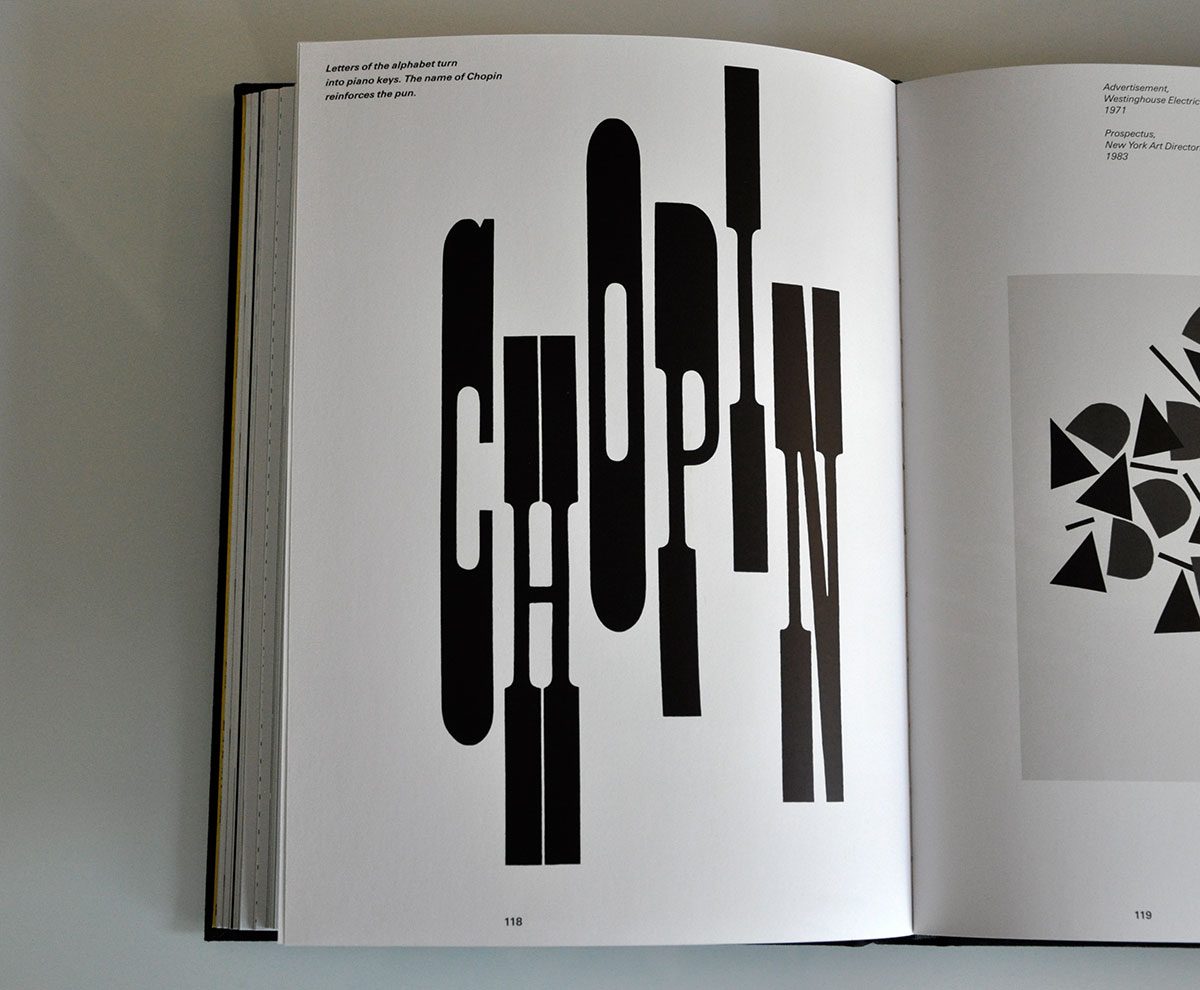A quick Google search for “logo design” pulls this top 10:
- logoyes.com
- logoworks.com
- logodesign.com
- logodesignguru.com
- thelogocompany.net
- logomaker.com
- logoblog.org
- logomyway.com
- e-logodesign.com
- logodesignworks.com or logoinn.com (interchangeable)
The majority have been running for many years, and have generated a huge amount of backlinks (SEO equity).
#2 on the list, Hewlett Packard’s logoworks.com (embroiled in the incredible Logoworks saga from a few years back), also owns #3, logodesign.com, and #6, the DIY logomaker.com.
#4, Logo Design Guru (LDG), has it’s own DIY logo maker, logosnap.com, which hovers around #15 in Google’s results. LDG also owns “Graphic Design Blog” (graphicdesignblog.org) which you might’ve seen — a site known for the practice of logo raiding (where logos are featured without crediting the designer, purely to boost visits and SEO). The main banner on graphicdesignblog.org points to the LDG-owned design contest site, mycroburst.com (I’ve already talked about the problem with online design contests).
LDG has its own WordPress blog (logodesignguru.wordpress.com) that does a nice job of logo raiding.

Is that my hand on the LDG blog? Yep.
But I think LDG’s WordPress-hosted effort (screen-grabbed above) is a lesser link-generation project than its main blog — and #7 on the list — logoblog.org. That one showcases what’s labelled as a client-determined list of the top 10 logo design companies — can it be a coincidence that the owner is ranked at #1, with sister-site Mycroburst at #2.

LDG has yet another design blog (blog.logodesignguru.com) where I found this useful quote:
“Don’t be a thief. Blogs are meant to share genuine thoughts and opinions and although content writing can be difficult at times, it’s better to have the satisfaction of knowing that ideas you share actually belong to you and are completely original.”
Good advice. So it’d be nice to see logoblog.org and graphicdesignblog.org practice what they preach by giving credit to the oblivious designers whose work is being regurgitated for the ubiquitous posts such as “20 great (insert animal name here) logos.” No link. No credit.
Paid links with specific anchor text
One of the more effective ways of getting strong search engine rankings is through links that point from other sites to yours (the strength, or trust, of the site linking to you makes a huge difference) which is why #8 on the list — the design contest site logomyway.com — is continuously buying “paid reviews” on high-traffic blogs such as John Chow, SpeckyBoy, 1stWebdesigner, WebAppers, and many more.
I got a Google penalty for selling links without using the “nofollow” tag (Google urges webmasters to use this tag on paid links so they don’t game the system), but nowadays it seems like Google has become less strict, because all of the above reviewers (with the exception of John Chow — who knows more than most about the consequences) have sold Google juice to logomyway.com (i.e., they don’t use the “nofollow” tag), therefore helping elevate the contest site up the search engine rankings.
The paid reviews listed above use specific anchor text in the links pointing to logomyway.com (and I’ll bet the words were specifically requested when the review was purchased). “Logo design” or “logo designer” for instance. The reason? Linking to logomyway.com using the text “logo design” will help the site rank higher for that specific search term.
Last year SEOmoz listed keyword-focused anchor text from external links as the most important ranking factor.
The value of strong, “trustworthy” incoming links is demonstrated by #1 on the list, logoyes.com. It’s part of the high-traffic Web.com Group, and a vast amount of Google juice is passed between the various Web.com brands, making logoyes.com an incredibly difficult site to topple.
Don’t compete. Stand out.
I don’t compete with companies who offer a logo and nothing more (or 99 logos, for that matter). In the words of Michael Bierut, “logos are not that hard to do.” In fact, it’s practices like those I’ve described that frequently have me second-guessing my decision to name this blog Logo Design Love.
My advice for the aspiring designers amongst you is to not concern yourself with these companies or the search results they occupy. Instead, offer your clients more than just a logo. Offer a visual identity system that incorporates a complete range of promotional items (stationery, signage, usage guidelines, web presence, etc.).
If a client needs something you can’t provide (or something you prefer not to specialise in) why not partner with other graphic designers? You may find you can attract a much higher calibre of client, too.
By focusing less on logos, and more on brand identity systems, you will remove the need to compete with the lowest common denominator.
That’s how to strengthen your position in the market.
Logo SEO posts elsewhere:





Comments
Nicely written David. There will always be companies sporting products that are inferior than the Internet rank they’ve paid for (I’ve always wondered if they pay more attention to ranking than product quality). So chiseling out your own niche with a product your clients can really use is the way to go.
It’s sad to see how desperate some so called designers are. I think education is the only way to make people aware of this unhealthy trend. As a matter of interest, it is like developers selling modified building floor plans for a fraction of the cost of consulting an architect. This price war is going to continue and the professionals should continue to find new ways to educate their cyber clients and advertise their services.
Fantastic article. It’s almost like feeding the trolls to compete with these guys. They are happy and smug as they sit at the top of the logo searches pile, albeit nervously, but the pile is made of spam.
I’d say leave the victors to their spoil and focus on the whole visual identity system, as you say.
They must generate thousands of hits for a few bucks, because I’d gather that most people who, in earnest, search for a logo designer and find these guys instead, are not really looking for their kind of cheap spammy company. I really wouldn’t be surprised to see some of these sites and names up for auction in a few years. But someone else will grab them and do the same thing. The temptation for a fast (though unsustainable) buck is too much for some people.
If you have to resort to these kinds of stupid tricks while being in the top ten search result, you can rest assured there is some kind of cash flow problem going on. If you are number one and can’t generate revenue without resorting to SEO tricks and shenanigans like this, you must be doing something wrong.
David, I knew there was a fair bit or collaborating, cross-linking and generally shady SEO practices going on, but I had no idea that it ran this deep. You have really opened my eyes in this post.
When you say that you have been second-guessing naming this blog Logo Design Love, are you inferring that you should have named it Brand Identity Love?
Nah, just doesn’t have the same ring to it ;)….
Focusing on brand identity systems is terrific advice.
I have updated my original post with a link-back to this one. Thanks for the mention.
I agree. Coca Cola isn’t a great logo, but how it was used is. Nike’s logo wasn’t great either until it was used with confidence on their ads and became just a tick (you can tell a NIKE ad just by the general styling).
You can tell a make of car by certain little design elements they have (the front grill, the way the back screen wraps around the rear window, tail lights etc) that are just as important in maintaining their identity as their symbol or logo.
It’s a complete package based on a simple idea, executed with craft and care, displayed with confidence that is the real value of good design.
Very well constructed article David. It’s a dog eat dog world at the top of Google and most of our competitors practice big company, strong arm tactics to maintain their piece of the pie.
We have been ranked as high as No.2 for Logo Design in the past, though due to google seemingly slackening their spam filters we have seen our genuine efforts erroded over the last few months and are now sitting at 5 or 6 for this particular term.
We are about to launch our revamped website as our current one is now clearly outdated. Risky as this will be we need to do it to level the playing field and give the consumers a bigger choice.
It’s a strange market we frequent but a little like the car industry in some respects. At the bottom end of the market you have the mass consumed models for the lowest amount of money. In amongst the masses you can get a little diamond in the rough like say the new Fiat 500’s but the majority just about get you from a to b for a low price. Then you have the mid range stuff like the family saloon. This could be compared to people like yourself David who provide a decent bit of kit for a reasonable amount of money. In that same range alas you get some pretty shocking designers too as you get some pretty shocking cars. Right at the top you have the super cars and the top marques. Your Saatchi and Saatchi of the corporate world if you like. Again you can get some real hit and miss design at this price range too.
If you can’t feed your family as a good designer then you need to either work for someone who will pay you what you are worth or you need to learn some better business skills and make it on your own. It’s pointless wasting your efforts trying to educate people against using online logo design at a budget price as it is pointless against advising people not to use supermarkets over corner shops. They are not going away anytime soon.
Your own SEO efforts David have seen you climbing up the ladder nicely and rightly so in my book.
Keep up the good work.
Simon
Cat, I hope the red shirt demonstrations aren’t causing you too much hassle over there. I was reading about it online earlier.
Duane, I agree, Brand Identity Love doesn’t have quite the same ring to it. My second-guessing comes as the result of the work I do, and how increasingly, I’m moving further and further away from where I started (producing a logo in isolation) to where a more enjoyable process lies (crafting a complete brand identity package). The logo is still an important part of the mix, and there’s a fantastic community of designers within this site. Building something similar but on a slightly different course would take time.
Doug, it wouldn’t surprise me, either. It must take an incredible amount of time and effort, and at what cost?
Simon, good luck with your new site launch.
Lee, great quote:
Interesting stuff David. I have developed a mild addiction to checking out these kinda websites and marveling at the terrible clip-art nature of the content on offer, and the sheer amount of rubbish spouted when it comes to explaining their so called ‘processes’. I know I shouldn’t but I just can’t help it…
Thanks David. The Red Shirts are a temporary problem. I’m more worried about what the Thais will think up next, and how much more that’ll tear their country apart.
But it’s not too difficult to get around and do what needs to be done, just avoid their camping ground is all. And don’t wear yellow.
I spent four days with the the Red Shirts in the beginning, documenting the events via photos and video. But I don’t do blood. And I don’t like the idea of snipers.
Brilliant post, David. “Black Hat” SEO and other search-ranking gimmicks can be both fascinating and shocking in the extremes to which they game the system and trample ethical considerations. My employer strives to educate clients about proper, above-board SEO practices, as in this example: http://askhaley.haleymarketing.com/?p=712 (please forgive the plug, but I’m totally with you on exposing this sort of thing).
Differentiation is a great way to work around these workarounds. :)
This is precisely what I’m talking about in terms of “logo raiding” from Logo Design Guru (owners of LogoBlog, Mycroburst, Graphic Design Blog, et al):
http://www.logoguru.co.uk/thoughtful-balck-white-logos/
All the logos shown are most likely lifted from LogoPond, except none of the designers (and it’s not difficult to read their names from the source) are given credit. Not even a link to LogoPond.
Additionally, how many times can one mention the words “logo design” or “logo designer” in the full 10 sentences of the post? I count 13. A clear case of keyword stuffing.
I’ve been contacted by someone who used to work as a search marketing manager for one of the top five results. He’s given me an inside look at how these companies operate, and I’ll share the details in a soon-to-follow update.
I think it will be matter of time when Googles algorithm changes so that it doesn’t score domain names as high when the content or quality is not there. We hope Google look at the usefulness and quality of site content.
Great post, David. I think your suggestion to offer a full range of services including complete identity systems is wise advice. Offering those things means you are capable of delivering a broader branding strategy anyway.
Dear David, now this is a much needed discussion that you initiated here. Even if you hadn’t mentioned logoinn I would have felt obliged to take part in this discussion.
You mentioned that the companies on top ten results are in the business for years. Logoinn was launched nearly eleven months ago. So we are not exactly as old as these other companies are.
We do not get much traffic from search engines on these particular keywords that you mentioned above. We do work on these keywords but our purpose is to create brand awareness and brand recognition not traffic.
We do not buy links, we believe it is useless. Instead we try really hard to get actual links. Our strategy is to contribute content to other relevant blogs, social bookmarking of our packages and discount offers, blogging on relevant topics on our blogs, and high quality content generation on topics such as web design, marketing, brand identity, etc. We then submit this content to free content directories for a link back. I am sure you know that these content directories provide a noFollow linkback.
We also actively take part in discussions on the websphere specially those relevant to our business.
We try very hard to resist logo raiding and you will see that whenever we share someone’s work on our blogs we do mention the designer and we link back to the source of the image as well.
We strongly denounce evil SEO techniques, copyright infringement, crowd slavery (the so called contests), logo raiding, etc.
We are a small company and we just try our best to compete with much more resourceful people in the business without being evil. We are allowed to do that, aren’t we?
We have the site that mostly ranks at first position in Google UK for logo design and, I must admit, we spend a few hundred pounds a year on SEO. I am proud that my partner and I registered Logo Design as a partnership in 1976 and I have read that Google gives points to sites according to how long they have been on the web (we registered our URL 11 years ago). So do the ‘old farts’ have it? I think you are right with your advice David but there is another tactic to employ on the web and that is using your location. ‘Logo design Plymouth’ will out rank us even though Plymouth is our nearest city. And companies like mine can bang on all they like about doing business over the web but, at the end of the day, there is nothing to beat meeting face to face.
11 months, Joey? That’s some going. Would you say a certain portion of the company’s working day is devoted to building the rankings, and if so, how much?
Chris, the old farts definitely have an advantage — particularly with the relevant URL keywords. Do you spend money on SEO by hiring outside help?
Hi David, we use an outside company for SEO and have used them for several years; they are squeaky clean white hatters. I have tried link building using free and paid for web directories in the past but this is a tedious chore and, I suspect, a con of gigantic proportions (it would be interesting to hear what your ex-SEO manager thinks about this). I too agree with everyone about the importance of content and I am sure Google is far more focussed on this these days than the original Page Rank algorithm based on in bound links.
Good to know you team with white hatters, Chris. All the best with your future efforts, too.
Dear David,
We have a marketing department and our main focus is online marketing and social networking. So there is no specific time set for link building, links come naturally to us. We came up so quickly most probably because our link backs are genuine and relevant to our business.
We would love to know how others and especially you spend time on link building?
It’s just writing about interesting design topics, Joey. I don’t spend time submitting to directories, thinking of keyword-rich landing pages, or exchanging links. I write about what catches my eye.
Nice article; A really good way to build quality linkbacks is to do a backlink check on a some of the top search results and follow exactly what they do. Most of the top sites will have “legitimate” links, but you’ll find a lot of the other top sites are using paid directories and blog comments. Hey the Japanese do it all the time! Also, target keywords that aren’t so difficult to overcome. Its better to be on the front page of “Denver Logo Design” than the 2nd page of “Logo Design”
It definitely is a hard struggle. On the one hand, how do you compete against the companies that can afford to spend thousands of dollars to have thousands upon thousands of random spammy backlinks pumped in. On the other, you really dont want to “descend” to that level so to speak. This has been a really interesting article. I wonder whether or not this kind of spammy SEO work actually negatively impacts business? I would think not, simply because most customers are not aware of it?
There really is some sh#t out there. So much, that I’m going to struggle to get to the top, or anywhere near in fact.
They may have their backlinks, but we have something you can’t buy or cheat, and that’s quality.
Hi David,
Came this post by chance. Great information, insights and the discussion that followed. I hope I am not too late to comment here.
Just wanted to add that everything you spoke about last year in relation to quality content, branding, differentiation, social, and most importantly ‘buying links’ has come true this year with Google kicking out hundreds of updates that have helped to get rid of a lot of spam and low quality content.
So therefore I completely agree with what you were saying!
Hi David,
A fabulous read.
It is getting increasingly difficult to get your portfolio noticed online unless you are willing to pay a small fortune to one of the internet giants. And what’s to say that you spend most of your time dealing on the phone with businesses trying to sell you services and products. I am lucky with my referrals from clients and friends.